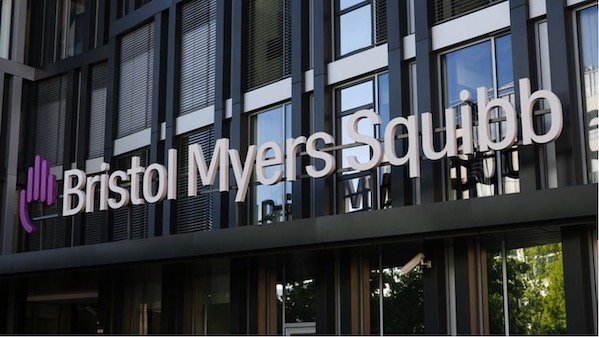Bristol Myers’ $4B plan for Reblozyl takes shape in blood cancer anemia—with one caveat
May 29, 2023
Source: drugdu
 493
493

Bristol Myers Squibb’s Reblozyl could be an effective initial treatment for anemia patients who are suffering from a group of blood cancers called myelodysplastic syndromes (MDS) and are at a relatively lower risk of progression.
That’s the conclusion reached by Olatoyosi Odenike, M.D., from the University of Chicago Medical Center, after she reviewed data from the phase 3 COMMANDS trial that are slated to be presented at the 2023 American Society of Clinical Oncology (ASCO) annual meeting. Odenike is an invited ASCO expert and an opinion leader in the MDS field.
The COMMANDS trial is the first study in decades that has shown a benefit for a new agent against erythropoiesis-stimulating agents (ESAs) in low- to intermediate-risk MDS, Noah Berkowitz, M.D., Ph.D., senior vice president of hematology development at BMS, said in an interview with Fierce Pharma.
If the FDA eventually agrees with Odenike’s finding, Reblozyl could move from behind traditional ESAs to first-line treatment of MDS. And the drug may also expand beyond a subtype of patients with ring sideroblasts (RS), which are blood cells that contain rings of iron deposits around the nucleus.
Success in first-line MDS for a broad patient population would be a key step toward Bristol Myers’ internal goal of $4 billion in peak sales for Reblozyl, William Blair analyst Matt Phipps, Ph.D., pointed out in a note early May.
About 30,000 patients are diagnosed with MDS each year in the U.S., with more than 70% classified as having lower-risk disease. With Reblozyl, BMS is targeting the roughly 60% of those patients who require transfusions.
But the phase 3 results from the COMMANDS trial still leave one shortfall in Bristol Myers’ case.
In the COMMANDS study, Reblozyl beat Amgen and Johnson & Johnson’s Epogen/Procrit at helping more patients live free of transfusion for at least 12 weeks with an average hemoglobin increase of at least 1.5 g/dL. The transfusion independence rate was 58.5% for Reblozyl and 31.2% for the ESA agent in the first 24 weeks of treatment.
However, thanks to a previous leak of abstracts, industry watchers knew that Reblozyl’s advantage in the study’s primary endpoint was entirely driven by patients with RS. In those patients, Reblozyl hit its goal in 64.8% of patients, versus 25.9% for those on ESA. In RS-negative patients, Reblozyl performed slightly worse with a 41% transfusion independence rate, compared with 46.3% for ESA.
Despite this, Guillermo Garcia-Manero, M.D., from the MD Anderson Cancer Center, who presented the COMMANDS data, said in a press briefing that he supports upfront Reblozyl use in RS-negative MDS patients.
The response rates between Reblozyl and ESA in RS-negative patients were “quite similar,” Garcia-Manero said. He pointed to the duration of response as another key endpoint affecting patient outcomes. There, investigators found that Reblozyl was roughly twice as good as the ESA at inducing durable responses in RS-negative patients, although the number wasn’t statistically significant. The median duration for this subgroup wasn’t reached, whereas the control group recorded a median 95.1 weeks.
Reblozyl demonstrated a “profound difference” from ESA in terms of duration of response in the overall trial population, BMS’ Berkowitz said. In all patients, ESA recorded a median duration of 77 weeks, versus 126.6 weeks for Reblozyl.
Berkowitz also argued that RS status is losing relevance as a determinant in MDS treatment. Instead, mutational markers have gained importance, he said, and Reblozyl showed similar benefits across key mutations.
Reblozyl also boasts a convenience edge over Epogen/Procrit because the BMS drug is given as an injection once every three weeks, whereas the traditional ESA is injected once every week.
On a secondary endpoint, Reblozyl performed better in the overall population when it came to inducing hematologic improvement-erythroid response of at least eight weeks, which indicates less reliance on transfusions. The rates were 74.1% and 51.3% for Reblozyl and control, respectively.
“I think this is going to be a paradigm shift for a majority of our patients,” Garcia-Manero said of Reblozyl in lower-risk MDS.
After an original approval in 2019 for beta thalassemia, the FDA in 2020 cleared Reblozyl to treat anemia in lower-risk MDS patients—but only after they fail on an ESA and only in those with RS. BMS got Reblozyl through its acquisition of Celgene and pays sales-based royalties to Merck & Co. after the New Jersey pharma bought the drug’s original developer, Acceleron.
BMS has already filed Reblozyl for a label expansion in the first-line setting, and an FDA priority review has put the target decision date at Aug. 28. The current data came from about 80% of study patients. Meanwhile, investigators are also waiting for all patients to complete their 24-week treatment, and they will be followed for up to five years.
Reblozyl is one of seven recently launched products that BMS hopes will collectively turn in $25 billion sales in 2030. Besides MDS, the company is also testing Reblozyl in myelofibrosis-associated anemia in the phase 3 INDEPENDENCE trial.
Reference: https://optionshawk.com/wp-content/uploads/OptionsHawk-Market-Outlook-2020.pdf
By editorRead more on
- Over $2 billion! Another major deal for a domestically developed innovative drug December 24, 2025
- Good news for middle-aged and elderly men! Taincon has become the first generic version of a compound drug for benign prostatic hyperplasia December 24, 2025
- BeiGene – Catadegbrutinib Initiates International Multicenter Phase II Clinical Trial for B-Cell Leukemia December 24, 2025
- IND for Oral Small-Molecule KRAS G12D Inhibitor ABSK141 Approved by NMPA December 24, 2025
- Wantai Bio’s bivalent HPV vaccine (Escherichia coli) was shortlisted for the National Immunization Program (NIP) December 24, 2025
your submission has already been received.
OK
Subscribe
Please enter a valid Email address!
Submit
The most relevant industry news & insight will be sent to you every two weeks.



